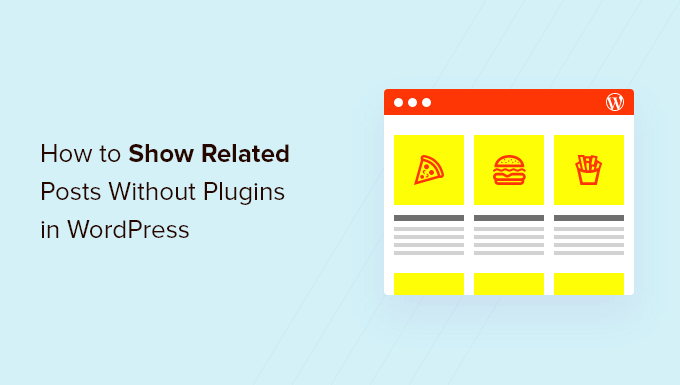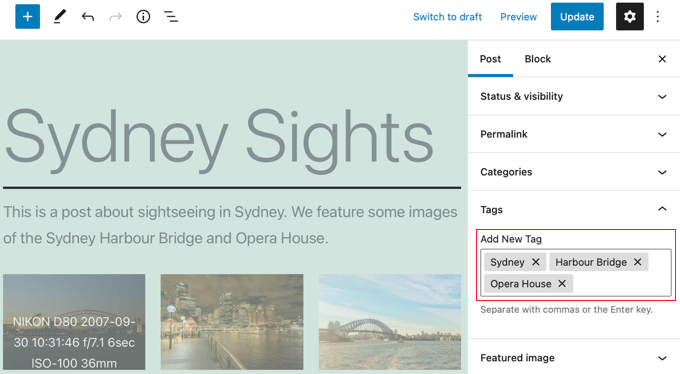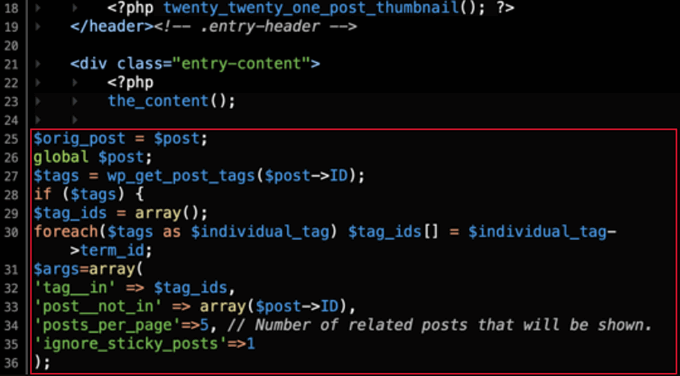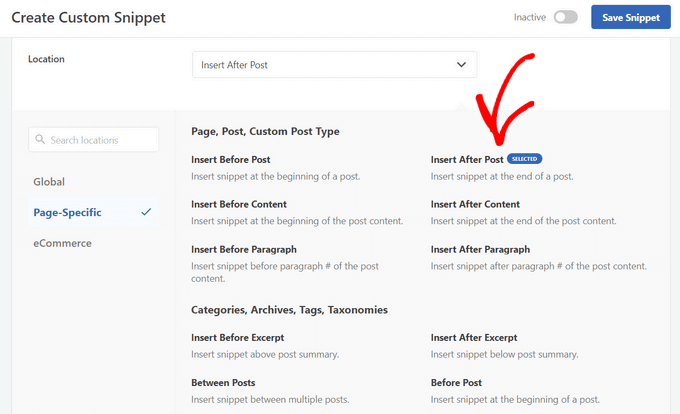¿Desea mostrar una lista de entradas relacionadas en su sitio web de WordPress y prefiere utilizar código en lugar de un plugin?
Cuando los visitantes de su blog hayan terminado de leer un artículo que les interese, ofrecerles una lista de entradas relacionadas les mantendrá interesados y les ayudará a encontrar nuevos contenidos que leer.
En este artículo, le mostraremos cómo mostrar entradas relacionadas con WordPress usando código, sin necesidad de plugins.

¿Por qué mostrar páginas relacionadas en WordPress?
Cuando tu blog de WordPress empieza a crecer, puede resultar más difícil para los usuarios encontrar otras entradas sobre el mismo debate.
Mostrar una lista de contenidos relacionados al final de cada entrada del blog es una buena forma de mantener a los visitantes en su sitio web y aumentar las visitas. También ayuda a mejorar la visibilidad de las páginas más importantes al mostrar los mejores contenidos donde la gente pueda encontrarlos fácilmente.
Si no está familiarizado con el código, entonces le resultará más sencillo elegir uno de los muchos plugins de WordPress para entradas relacionadas que pueden mostrar entradas relacionadas sin código.
Pero si alguna vez te has preguntado si puedes mostrar entradas relacionadas sin usar un plugin, entonces compartiremos dos algoritmos diferentes que puedes usar para generar entradas relacionadas con miniaturas usando sólo código:
Nota: Si desea mostrar una miniatura con cada entrada relacionada, asegúrese de añadir primero una imagen destacada a esas entradas.
Método 1: Cómo mostrar entradas relacionadas en WordPress por etiquetas
Una forma eficaz de localizar contenidos relacionados es buscar otras entradas que compartan las mismas etiquetas. Las etiquetas suelen utilizarse para centrarse en los detalles específicos que contiene una entrada.
Teniendo esto en cuenta, puede que desee seguir adelante y añadir algunas etiquetas comunes a las entradas que desea relacionar entre sí. Puede introducirlas en el cuadro “Etiquetas” del editor de WordPress.

Después de haber añadido etiquetas a tus entradas, lo siguiente que tienes que hacer es añadir el siguiente fragmento de código a la plantilla single. php de tu tema. Si necesitas ayuda para añadir código a tu sitio, consulta nuestra guía sobre cómo pegar fragmentos de código de la web en WordPress.
$orig_post = $post;
global $post;
$tags = wp_get_post_tags($post->ID);
if ($tags) {
$tag_ids = array();
foreach($tags as $individual_tag) $tag_ids[] = $individual_tag->term_id;
$args=array(
'tag__in' => $tag_ids,
'post__not_in' => array($post->ID),
'posts_per_page'=>5, // Number of related posts that will be shown.
'ignore_sticky_posts'=>1
);
$my_query = new wp_query( $args );
if( $my_query->have_posts() ) {
echo '<div id="relatedposts"><h3>Related Posts</h3><ul>';
while( $my_query->have_posts() ) {
$my_query->the_post(); ?>
<li><div class="relatedthumb"><a href="<?php the_permalink()?>" rel="bookmark" title="<?php the_title(); ?>"><!--?php the_post_thumbnail(); ?--></a></div>
<div class="relatedcontent">
<h3><a href="<?php the_permalink()?>" rel="bookmark" title="<?php the_title(); ?>"><!--?php the_title(); ?--></a></h3>
<!--?php the_time('M j, Y') ?-->
</div>
</li>
<!--?php }
echo '</ul--></ul></div>';
}
}
$post = $orig_post;
wp_reset_query();
Este código busca etiquetas asociadas a una página y ejecuta una consulta a la base de datos para obtener páginas con etiquetas similares.
¿Dónde debes colocar el código? Eso depende de tu tema, pero en la mayoría de los casos, deberías poder pegar el código en la plantilla single. php de tu tema después de la entrada principal y justo encima de la sección de comentarios.
Si utiliza el tema Twenty Twenty-One, como nosotros en nuestro sitio de demostración, un buen lugar para pegar el código es en el archivo template-parts/content/content-single. php después de la cabecera y justo después de <?php the_content();.

Esto mostrará automáticamente el contenido relacionado en cualquier entrada de WordPress. Tendrás que cambiar el estilo y la apariencia de tus entradas relacionadas para que coincidan con tu tema añadiendo CSS personalizado.

Consejo: En lugar de editar los archivos de su tema, lo que podría romper su sitio web, le recomendamos que utilice un plugin de fragmentos de código como WPCode.
WPCode hace que sea seguro y fácil añadir código personalizado en WordPress. Además, viene con opciones de ‘Inserción’ que le permiten insertar y ejecutar automáticamente fragmentos de código en lugares específicos de su sitio WordPress, como por ejemplo después de una entrada.

Para más detalles, consulte nuestra guía sobre cómo añadir código personalizado en WordPress. También puedes comprobar nuestra detallada reseña de WPCode para saber más acerca del plugin.
Método 2: Cómo mostrar entradas relacionadas en WordPress por categoría
Otra forma de mostrar contenido relacionado es listar entradas que estén en la misma categoría. La ventaja de este método es que la lista de entradas relacionadas casi nunca estará en blanco.
Como en el método 1, tienes que añadir un fragmento de código a la plantilla single. php de tu tema o en un plugin de fragmentos de código como WPCode. Para más detalles, consulta el Método 1 y nuestra guía sobre cómo añadir código personalizado en WordPress.
$orig_post = $post;
global $post;
$categories = get_the_category($post->ID);
if ($categories) {
$category_ids = array();
foreach($categories as $individual_category) $category_ids[] = $individual_category->term_id;
$args=array(
'category__in' => $category_ids,
'post__not_in' => array($post->ID),
'posts_per_page'=> 2, // Number of related posts that will be shown.
'ignore_sticky_posts'=>1
);
$my_query = new wp_query( $args );
if( $my_query->have_posts() ) {
echo '<div id="related_posts"><h3>Related Posts</h3><ul>';
while( $my_query->have_posts() ) {
$my_query->the_post();?>
<li><div class="relatedthumb"><a href="<?php the_permalink()?>" rel="bookmark" title="<?php the_title(); ?>"><!--?php the_post_thumbnail(); ?--></a></div>
<div class="relatedcontent">
<h3><a href="<?php the_permalink()?>" rel="bookmark" title="<?php the_title(); ?>"><!--?php the_title(); ?--></a></h3>
<!--?php the_time('M j, Y') ?-->
</div>
</li>
<!--?php }
echo '</ul--></ul></div>';
}
}
$post = $orig_post;
wp_reset_query();
Ahora verá una lista de contenidos relacionados en la parte inferior de cada entrada.
Si desea cambiar el estilo y la apariencia de sus páginas relacionadas, entonces tendrá que añadir CSS personalizado para que coincida con su tema.
Esperamos que este tutorial te haya ayudado a aprender cómo mostrar entradas relacionadas con miniaturas en WordPress sin plugins. Puede que también quieras aprender a hacer un seguimiento de los visitantes de tu sitio WordPress, o comprobar nuestra lista de 24 consejos para acelerar tu sitio web.
If you liked this article, then please subscribe to our YouTube Channel for WordPress video tutorials. You can also find us on Twitter and Facebook.





Syed Balkhi says
Hey WPBeginner readers,
Did you know you can win exciting prizes by commenting on WPBeginner?
Every month, our top blog commenters will win HUGE rewards, including premium WordPress plugin licenses and cash prizes.
You can get more details about the contest from here.
Start sharing your thoughts below to stand a chance to win!
imranhunzai says
Absolutely awesome! and yeah it helps.
8MEDIA says
amazing post ,, thanks
shaileshtr says
It is good to show related post in wordpress blog without plugiN. iIt will consume less bandwidth and time to load. http://shareitto.com Thanks for your suggestion.
zioneyemedia says
I do have a question on this: I’m wrestling on the code to capture posts from child categories versus parent categories. Any advice?
AmandaLong says
This rocks … Thanks!
dustinporchia says
I’m trying to use the related posts by category and I noticed that you said the code has to come before the comments in the main loop. In my code I want the related posts to come after the comments in the loop. When I do this I notice my disqus comment plugin takes longer to load now. Is that because of an error with the comments or is that normal?
dustinporchia says
Nevermind…I just switched to livefyre as this is more of what I’m looking for in a comment system anyways…thanks!
subzerokh says
please
could someone help a newbie like me customize this script so it’ll display related post in an horizontal way?
from left to right..
instead of currently showing it from up to down, vertically…
zioneyemedia says
Hey,
How I did it is I replaced the and codes with my own html and css. The codes create lists for each post, and that is usually in a vertical fashion.
——————
<a href="” rel=”bookmark” title=””> <a href="” rel=”bookmark” title=””>
——————
I replaced the opening with and replaced the closing with as my html tags. Then I write my CSS to fit that specific div class needs on your website. For example, a sample pleft class could look like this:
.pleft {float:left; padding:2px; margin:10px; width:278px; height:190px;}
I use the float: selector on my CSS to move posts horizontally, and the margins and padding to give each post spacing within each other. I added in a specific width and height for additional examples.
Hope this helps.
Simos says
@zioneyemedia thank you!
gcog says
I’ve got related tags for sure, but when I add the code I see nothing. Also, when I add your code to restrict to a custom post type, it gives me an error. I did change the post type to my specific post type.
subzerokh says
@wpbeginner hello
thanks for your quick answer…
but i’m a real novice at all you are saying..
can you please give a litlle exemple?
for making them horizontal as on your own blog?
can get in touch by my mail: khiloc at gmail dot com
wpbeginner says
@subzerokh You would have to edit the styling. It is not that hard. Simply wrap each post in a div. Specify a width for that div and then set a float left property. Adjust the margins and such and you have it.
subzerokh says
hello all!! thanks for this wonderfull script!!
It’s the only thing i found doing exactly what i wanted!!!
But it’s just showing related post in vertical way (from up to down)
I would like it to be shown from left to right (horizontally)
How to do that please??
ConnectIndia says
Error Fatal error: Call to undefined function the_post_thumbnail() in /home/connec92/public_html/wp-content/themes/weekly/single.php on line 59 Can some one help. website http://www.connectindia.co.in
xavpro says
hey,
great post! maybe you could help me:
i have a auto thumb if none is defined,
if ($thumb_array[‘thumb’] == ”) $thumb_array[‘thumb’] = ‘link to your default thumbnail image’;return $thumb_array;
now my question is how to define a thumb for each category, which will be used if none is defined at post.
dehahs says
works nicely, thanks for sharing!
AdnanAsif says
Hi
thanks for your great post..
But any change to get posts by categories but not in ul and li and not in thumb..
I mean full posts show in related posts..just like show on home page, with readmore link.
thanks
waiting your reply..
AdnanAsif says
Hi
thanks for your great post..
But any change to get posts by categories but not in ul and li and not in thumb..
I mean full posts show in related posts..just like show on home page, with readmore link.
thanks
waiting your reply..
ibadullah25 says
Can I have a CSS For this please
Editorial Staff says
The CSS we used was for a client’s site. You can add your own CSS on how you want to display this.
Administrador
titusmagnet says
Thanks..im searching for this kinda Code
jaffa says
This is great, just what I have been looking for. I wonder though, how could I combine the two above and if there are no tags then it displays posts from the same category?
Trying to figure this out but not getting very far yet
nikbanks says
Thanks for the code it worked but how do I style it. I’d like it to be 4 stories side by side like yours. It is listed one on top of another on my site and not listed like yours.
Editorial Staff says
That is CSS. We are not using this code to show related stories. Second, i believe what you are talking about is featured stories on our sidebar. We have written another post about that in our site.
Administrador
Coolguy says
is ther a way to dispay the thumbs in related post without using featured images or post thumbs??
i.e to use any image used in the post …
Editorial Staff says
Yes, you can utilize the fallback techniques shared by other developers which pulls the first image from the post. But we recommend using the WordPress post thumbnails…
Administrador
Hetal says
Thanks for this article. I was wondering if there is a way to auto-tag posts without having to manually enter them.
Editorial Staff says
No you have to tag each post manually.
Administrador
Sisko says
Great!
What if I want to display related posts by category without thumbnails?
Thanks
Editorial Staff says
Just remove the thumbnail code from the code above
Administrador
Terry says
Thank you for posting this tutorial, it helps me a lot.
Adrian says
Hi there…Just wanted to say that I’ve been building my wordpress website from the ground up and this code works perfectly for me using WP 3.1….All I need to do now is style the CSS and get some thumbnails happening for the posts. Thanks for your help with the code.
new car release says
thanks, i’m looking this hack for so long and you got it to me!
Patricia says
Hi, is there a way to exclude categories? I have two main categories where all the categories get assigned to. The main categories have sub-categories and I would like to show just related posts from the sub-categories.
Is this possible, by excluding the id’s of the main categories?
Thanks for your advice!
BTW…love the code…and it works great!!!
Editorial Staff says
You should be able to use category not in <<
Administrador
usman says
I was searching for related post with thumbnails plugins but the code that you paste above, solve my problem.
John says
Just one question, is there a way to only pull tags from the same post type? Maybe using something like ‘post_type=videos’?
John says
By the way, got this figured out as well:
Just add it to the array:
$args=array(
‘category__in’ => $category_ids,
‘post__not_in’ => array($post->ID),
‘posts_per_page’=> 2, // Number of related posts that will be shown.
‘caller_get_posts’=>1,
‘post_type’=>’videos’
);
marion says
Hi,
Thank you for this tutorial. I’m wondering though if there’s anyway the related products can be randomized? I’ve checked different products in the same category and the same related products were shown.
Thanks
Editorial Staff says
Yes use the Query_Post parameter for order and you can randomize it.
Administrador
Clarence Johnson says
Good to know.
phdean says
Hi,
I too would like to randomize the posts that display for the categories as, otherwise, they’ll display the same 2 every time. Can you please give me the code to do this?
Many thanks in advance
John says
Nevermind, I got it figured out. Thanks for the post!
Editorial Staff says
what was the issue?
Administrador
John says
I didn’t have any other posts with the same tags, i.e. no related posts. Dummy mistake.
John says
I copied this code and put it in my single.php without changing a thing and nothing gets outputted. Anything wrong with my code? pastebin.com/kg0SkrAg
James says
This doesn’t bring up a thumbnail — there isn’t even a call for an image int eh code. I don’t see how anyone can get this to work.
Editorial Staff says
The code for the image is: the_post_thumbnail(); << This is not static html where you will see img src code. The function calls in the database to search for a featured image aka thumbnail that is attached to each article. If found, it will output the image. Now if you do not have post thumbnails enabled in your theme, then you need to add it first:
https://www.wpbeginner.com/wp-themes/how-to-add-post-thumbnails-in-wordpress/
The article clearly stated that in the Note: section. You should consider reading it thoroughly.
Administrador
Roberto Silva says
hey man, I love your blog!
I have a question?
Can you do the same trick but ” BY Author” ?
showing the latest posts by author?
you will save my life
Btw thanks for this website!
Editorial Staff says
Yes we will que the article soon
Administrador
Roberto Silva says
yessss, thanks…
It will be a great article.
bacause “latest posts by author without plugin” is hard to find on internet.
you are the best.
Quinn says
Thanks for this code! I’ve given it a try and it works somewhat.
I can get it to give a listing of the related articles, a huge benefit.
But I can’t seem to get any images to show up.
The articles have images if this code scrapes.
I also went in and created images for each post with the custom tag “relatedthumb”. But alas, still no images.
Is there something else I need to do?
Many thanks in advance!
Quinn
Editorial Staff says
This trick is using the default WordPress thumbnails which was added in WP 2.9. If you have an image attached as that thumbnail, then it will pull it.
Administrador
Anthony says
Is it possible to exclude a category from this module ?
Thanks a lot,
Anthony
Editorial Staff says
It will only shows post on the category that the other post resides in…
Administrador
Madhav Tripathi says
Hi, thanks for this good tutorial, currently I am using Thesis theme, so I want to know if there is a way in thesis theme implement this .php code.
Sophie says
I’m trying to modify his code in order to use it with categories within a custom post type. Can anyone help? I’m fairly new to php.
Thanks!
rulethenation says
ok i got it to work, is there anyway to put a default pic if a thumbnail is unavailable
Editorial Staff says
Yes, you can use the if paramter to check if there are plugins… if not then you can display a default image.
Administrador
rulethenation says
how would i go about doing that? im a php noob lol
Quickbrown says
In order to use default images when no post thumbnail available, replace with <?php if (has_post_thumbnail()) {the_post_thumbnail()} else {echo '’;} ?>
Then put a default-image.jpg under your themes’ image folder.
rulethenation says
i cant get this to work, it just messes up my whole layout near the comments, am i missing something? i had to take it off my site
Clarence Johnson says
My posts are now enriched thanks to you and this tutorial.
Heather Hill says
HI!
Thanks for this information! This is exactly what I was looking for.
Is there a way to add an excerpt to this, along with the photo?
Thanks again for your help!
Editorial Staff says
Yes. Just add the_excerpt(); where you want it to display excerpt.
Administrador
Jez says
Thanks for this, exactly what I was looking for! I love how straight to the point your articles are, no confusion.
Omer Greenwald says
Thanks for sharing. I’m using this code for a while now but it has a problem: when adding tags to a post, WP sorts them alphabetically regardless of the priority I added them. So this code displays related posts matching the first tag only which are less relevant sometimes.
Maybe you have an idea how to prevent this auto sorting of tags by WordPress or any other solution?
Editorial Staff says
It is not using the first tag. This code is using all tags from the posts to find related posts.
Administrador
Clarence Johnson says
I’m experiencing the same issue too.
Doug C. says
All that first code did was put two instances of the same post on the page. It didn’t show any related anything.
Editorial Staff says
Doug please contact us using the form with a live link example, and we can help. We know this code is working because a few of our client’s site is using it.
Administrador
Noor says
Very use article, thanks for updating
Liam says
Great tutorial. Would someone mind showing me a working single.php with this code?
I’m still learning php.
Unfortunately
Parse error: syntax error, unexpected T_ENDIF in C:\xampplite\htdocs\mock\wp-content\themes\scwd\single.php on line 76
Editorial Staff says
Here is a working example Flowtown Blog.
Note that this code is so it will work inside the loop. Where are you trying to post this? If it is outside the loop then just add the end if code endif; << like that.
Administrador
Liam says
http://pastebin.com/m60c96f5f
I hope the link works. Thank you.
Editorial Staff says
Don’t know what could be going wrong. After the clearfloat class it should work fine. That is how we put it in flowtown and it is working perfectly.
Liam says
I will finish the theme and try it on a live site instead of xamp. I will let you know.
Shahab says
Nice tutorial!
Right now i am using YARPP but would love to give this a try!
Thanks
Suriya Kumar P says
You guys r really doing a great job. thankz a lot.
Vivek @ InfoEduTech says
Thanks for this article. i am searching for lot of time to show the thumbnails with my article i am unable to perform this. i have tried many wordpress plugin but couldn’t done this. hope this might help me out